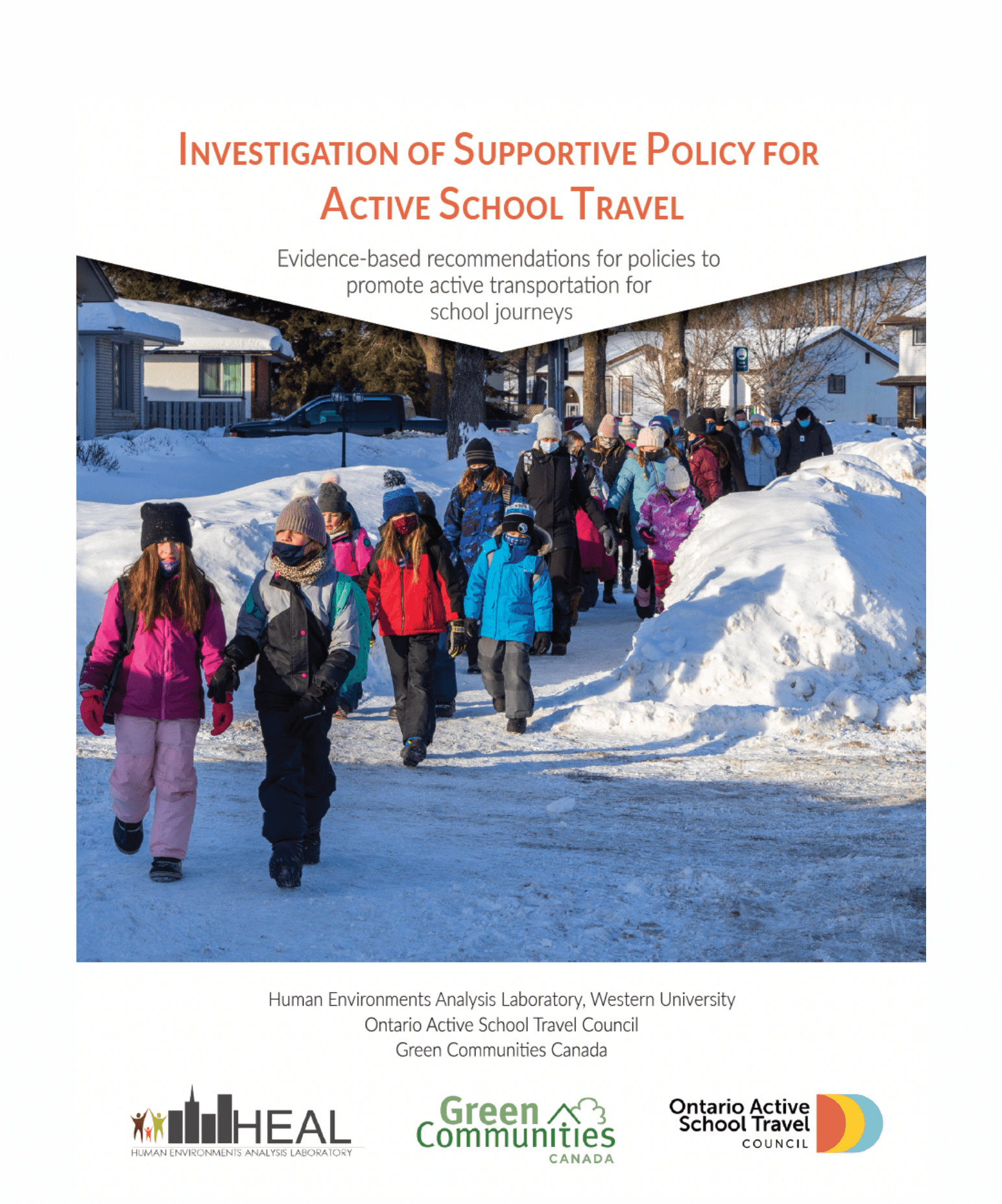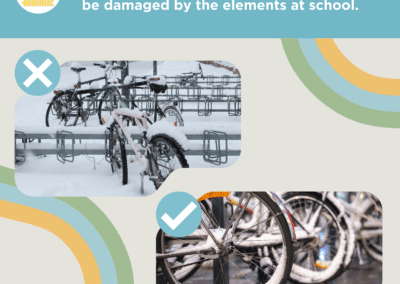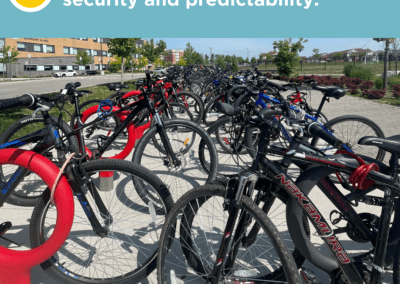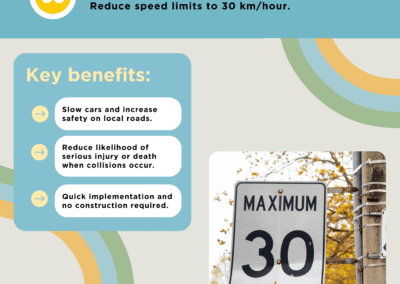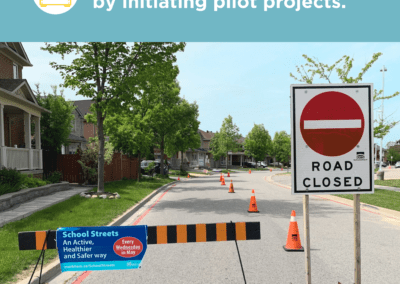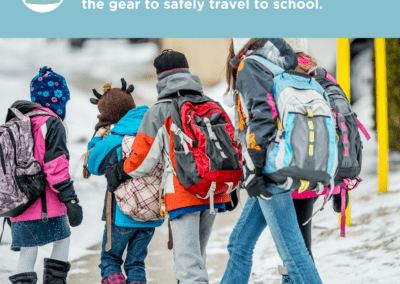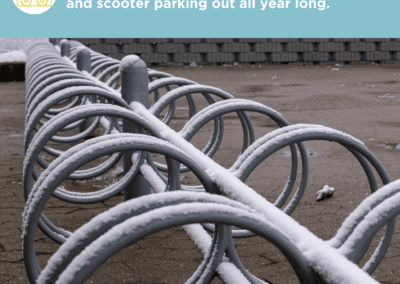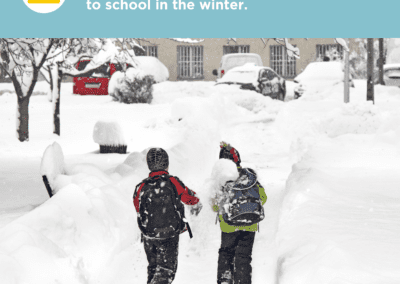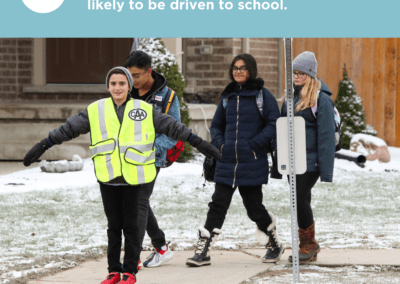Policy Recommendations
Looking for policy advice to support active school travel in your community?
Welcome to the home of policy recommendations that can be applied in communities across Canada to encourage active transportation for the school journey.
Green Communities Canada (GCC) partnered with the Human Environments Analysis Laboratory (HEAL) at Western University to develop evidence-based policy recommendations for schools, school boards, municipalities, and the provincial government. The findings of the research project are detailed in our report ‘Investigation of Supportive Policy for Active School Travel’.
GCC also partnered with The Centre for Active Transportation (TCAT) to develop advocacy assets to support the mobilization of recommended policies.
Key informant surveys and interviews
Regional environmental policy scans
Academic journal articles reviewed
Report Details
The research identified 57 recommendations across 5 key themes in which relevant policies could be implemented, including Planning, Infrastructure, School Site, Student Transportation, and School Travel Planning. Each section of the report explores relevant literature, provides a summary of existing policies and best practices, followed by a list of recommendations of policy statements. In addition, as a handy navigation tool, Appendix A of the report provides a listing of the primary authority and level of policy associated with each policy recommendation.
The research report demonstrates the critical role of policies and procedures in supporting and promoting active mobility and has been created to provide guidance for relevant decision-makers in the development of policies across communities.
Section 1: Planning
Municipal planning can support active school travel in many ways, including land-use design, traffic control, infrastructure, and school siting. The Planning section outlines policies that can support sustainability initiatives related to transportation mode shift, support connectivity and accessibility through network design, and planning schools for close proximity to children’s homes. The Planning policy recommendations fall into three themes: 1) Planning for Sustainability, 2) Planning Active Transportation Connections, and 3) School Location Planning.
Some key recommendations from the Planning section of the report include:
- A.2.3 Incorporate the NACTO All Ages & Abilities design standards to build communities that are accessible to the entire population. Cycling routes and other active transportation networks should prioritize schools as key origin-destination nodes.
- A.2.4 Establish a new designation of ‘Active School Travel Zone’ to create a framework for prioritizing roads and paths that are important routes for children in a community to access their school by active modes.
- A.3.1 Prioritize keeping schools in locations with appropriate walking and biking infrastructure open, as they are important community hubs and foster increased active school travel.
Section 2: Infrastructure
The built environment can greatly impact the accessibility and perceived safety of school travel routes. Infrastructure changes can help to mitigate perceived traffic safety concerns, such as protected intersections, traffic calming, and separate mobility lanes/paths. The infrastructure policies are organized into nine themes: 1) Complete Streets, 2) Cycling Routes, 3) Bicycle Parking, 4) Street Parking, 5) Use of Sidewalks, 6) Pedestrian Infrastructure, 7) Vehicle Speed and Traffic Calming, 8) Road Safety Education, and 9) School Crossings and Guards.
Some key recommendations from the Infrastructure section of the report include:
- B.4.3 Foster collaboration between schools and municipalities in the implementation of parking programs that encourage driving families to drop-off children farther from the school, such as ‘Drive to 5’, ‘Park & Stride’, & ‘Walk a Block’.
- B.5.1 Allow children 13 years of age and under to bike, skateboard, scooter, & rollerblade on any sidewalk.
- B.6.5 Provide snow clearing on sidewalks, multi-use paths, bike lanes, and cut-throughs to ensure they are accessible year-round. Active School Travel Zones should be prioritized for snow clearing.
- B.7.4 Restrict cars from entering streets immediately beside a school during the normal morning drop-off and afternoon pick-up times. Exceptions should be made for emergency responders, school buses, and caregivers of children with special needs or mobility limitations.
- B.8.1 Develop a School Crossing Safety strategy through collaboration between municipalities and School Boards to ensure safety improvements and Crossing Guards are provided where needed and are prioritized in locations of greatest need. Review ‘School Crossing Strategy’ every 5 years to account for changing infrastructure and needs.
Section 3: School Site
The school location choice and site design can connect to planning and infrastructure policies in support of active school travel. For example, school sites should be accessible from multiple entrances by developing a network of connective paths and the site design should consider limiting drop-off and pick-up locations. The School Site policies pertain to 1) School Site Design, 2) Parking and Drop-off Facilities on School Sites, and 3) Safe Arrival.
Some key recommendations from the School Site section of the report include:
- C.1.2 Provide sufficient, accessible, and secure bike storage at all school sites in a safe, visible location using the Association of Pedestrian & Bicycle Professionals Bike Parking Guidelines.
- C.2.2 Avoid installation of new ‘Kiss & Ride’ facilities to discourage driving children to and from school.
- C.3.2 Develop a ‘Traffic Management Plan’ for each school, working in collaboration with the municipality to create a safer arrival and dismissal experience for students and families accessing the school site.
Section 4: Student Transportation
School Boards govern policy and procedures related to student transportation services, with oversight and funding from the provincial government. Policy such as school bus service eligibility criteria can play a significant role in influencing travel choice. To support active and sustainable modes, policies should be considered for zoning criteria, bus stop locations, and idling in school zones. Such policies are broken down into sub-categories of 1) Vehicles, 2) School Bus Stop Location, and 3) Walking Distance Criteria.
Some key recommendations from the Student Transportation section of the report include:
- D.1.2 Move away from using the term ‘bus eligibility’ and establish new definitions for ‘walk zone’, ‘school bus zone’, and ‘out of catchment zone’ with all students falling into one of these three categories.
- D.2.1 Establish provincial standards for location of school bus stops, to include maximum distance from home and measures to provide safety and comfort for children using stops.
- D.3.1 Establish provincial standards for the ‘walking distance’ beyond which a student qualifies for school bus transportation.
- D.4.1 Investigate the implementation of electric/hybrid school buses and vehicles to decrease carbon emissions created from school travel and to decrease pollution children are exposed to while traveling to school.
Section 5: School Travel Planning
The School Travel Planning framework considers the individual and environmental factors influencing school travel to facilitate multi-sectoral collaboration. To implement School Travel Planning effectively, support is needed from a broad range of public stakeholders including the municipality, school boards and public health units. The ten policies recommended relate to 1) Funding & Partnerships, and 2) Education & Encouragement.
Some key recommendations from the School Travel Planning section of the report include:
- E.1.3 Encourage partnerships/collaborations between municipalities and School Boards in a community (e.g., Active School Travel Charter) to ensure they work together on common goals to support active school travel and school travel planning.
- E.2.1 Develop and/or implement pedestrian and cycling skills training so that all students gain a basic competency in these important life skills.
- E.2.3 Develop school board-wide encouragement and education campaigns to promote active school travel.
Sample Messages
The advocacy assets are accompanied by a comprehensive spreadsheet that outlines suggested text for Twitter (X) and Instagram, sample hashtags, and recommended Alt-Text. The content can be adapted to suit other platforms and purposes.
Download the sample messaging spreadsheet.
Visual Assets
The visual assets have been designed to support local advocacy around the key issues of winter maintenance, traffic calming, and bike parking at schools. They can be posted as threads or carousels, or shared individually.
Download all Winter Maintenance Assets TW / IG
Download all Traffic Calming Assets TW / IG
Download all Bike Parking Assets TW / IG
This is a project led by Green Communities Canada (GCC), the Human Environments Analysis Laboratory (HEAL) at Western University, and the Centre for Active Transportation (TCAT) made possible through financial support from Green Communities Canada, the Government of Ontario, and Mitacs.
Feature photo by: Dan Garrity Media via EcoSuperior

